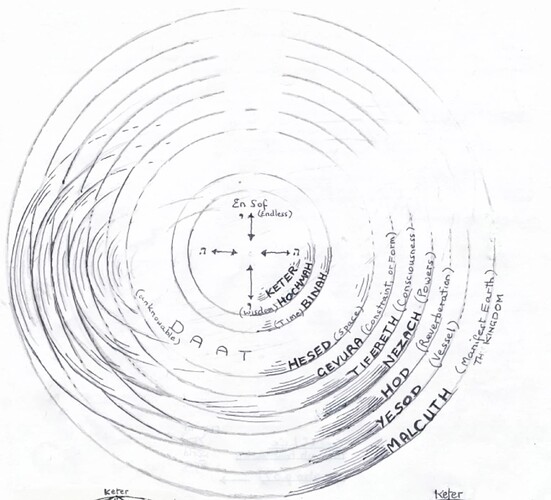 1. Overview of Kabbalistic Cosmology
1. Overview of Kabbalistic Cosmology
Kabbalah describes a multi-layered universe, created through emanations from the Infinite (Ein Sof), cascading through spheres (sefirot) and worlds (Olamot) down into the material.
But beyond just “up/down,” many texts conceive of reality as nested chambers or domes—which visually maps very well onto a concave containment system.
 2. Hechalot & Merkavah Mysticism (Pre-Kabbalistic Roots)
2. Hechalot & Merkavah Mysticism (Pre-Kabbalistic Roots)
The Hechalot (palace) literature—dating from ~1st–6th century CE—is an early Jewish mystical tradition where the soul ascends through chambers, firmaments, and veils to reach the divine throne.
Each layer contains:
- Guardians (angelic gatekeepers or filters)
- Names and vibrations
- Architectural structure (walls, ceilings, floors)
Implication: Reality is structured like an inner temple, with you inside it, trying to ascend inward and upward, like climbing from within a vast, nested cosmic shell.
 3. Seven Heavens: A Literal Model?
3. Seven Heavens: A Literal Model?
Kabbalistic texts (especially Zohar and Sefer HaBahir) describe seven heavens, not metaphorically, but as spherical, nested realms.
- Stars and constellations are placed in raqia, the second heaven.
- The lowest heaven is Vilon (veil)—it hides light by day and reveals it by night.
Each heaven has function, geometry, and celestial bodies within it.
Zohar I:4b — describes the stars as “hung” in the firmament by cords, moving only by divine permission.
Sounds a lot like celestial mechanisms embedded in a fixed sphere, doesn’t it?
 4. The Inverted Tree / Shell Metaphor
4. The Inverted Tree / Shell Metaphor
Some later Kabbalists described the worlds (Atziluth, Beriah, Yetzirah, Assiah) as shells around the spark—inverted from the modern “external heavens” model.
- Assiah (our world) is the outermost, densest shell.
- Inside are ascending layers of refinement.
- The divine is not out there, but deep within the center—reminiscent of concave cosmology.
Rabbi Isaac Luria’s Tzimtzum doctrine suggests the Infinite contracted to make space within itself for the world.
This space is hollowed—a vacuum inside the divine—a cosmic womb or shell.
Again, this flips the cosmological map inward.
 5. Klipot (Shells) and Cosmic Containment
5. Klipot (Shells) and Cosmic Containment
Kabbalists also speak of Klipot—the “husks” or shells that trap light or consciousness.
- Souls are born into these shells.
- These are energetic prisons, often associated with false structures, illusions, and spiritual distortion.
- The sparks of divine light are trapped inside the shells and must be liberated—Tikkun (repair).
Metaphysically, this is a consciousness-based concave Earth model:
We are inside layers, and the stars themselves are boundaries, not horizons.
 Summary of Kabbalistic Features Resembling Concave Earth:
Summary of Kabbalistic Features Resembling Concave Earth:
| Feature | Description |
|---|---|
| Hechalot Palaces | Nested spiritual chambers — structured like a dome or temple |
| Seven Heavens | Layered, literal firmaments with stars embedded within |
| Stars on Cords | Zohar describes stars as hung from firmament — fixed, placed |
| Tzimtzum | God “contracts inward” — reality is inside the divine hollow |
| Klipot | Shells trap divine sparks — prison within a shell, must be transcended |
| Inward Hierarchy | Closer to truth as you go deeper inward, not farther “up” |
 Why This Supports a Concave View:
Why This Supports a Concave View:
- Rather than ascending outward to reach “God,” one moves inward—through firmament-like spheres.
- Stars are fixed markers within a grand architecture—not loose in infinite vacuum.
- The language of containment, nesting, veils, and shells mirrors the concave model, where you are inside a divine structure, not standing on the outside looking up.

